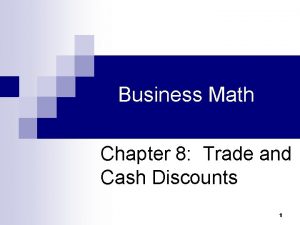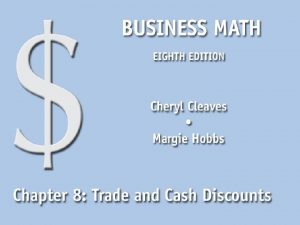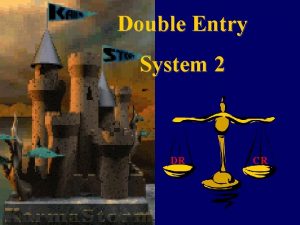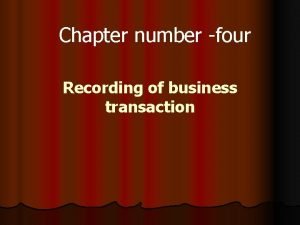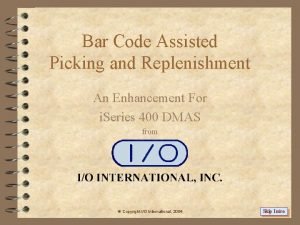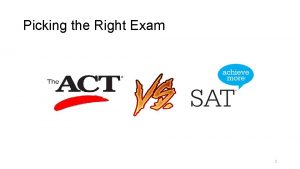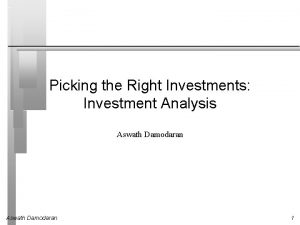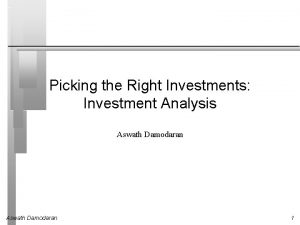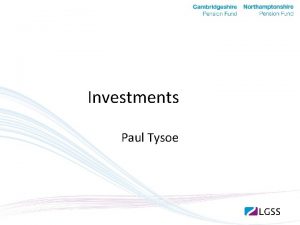Picking the Right Investments Choosing the Right Discount











- Slides: 11

Picking the Right Investments Choosing the Right Discount Rate P. V. Viswanath Based on Damodaran’s Corporate Finance

What is a investment or a project? w Any decision that requires the use of resources (financial or otherwise) is a project. w Broad strategic decisions n n n Entering new areas of business Entering new markets Acquiring other companies w Tactical decisions w Management decisions n n The product mix to carry The level of inventory and credit terms w Decisions on delivering a needed service n n Lease or buy a distribution system Creating and delivering a management information system P. V. Viswanath 2

The notion of a benchmark w Since financial resources are finite, there is a hurdle that projects have to cross before being deemed acceptable. w This hurdle will be higher for riskier projects than for safer projects. w A simple representation of the hurdle rate is as follows: Hurdle rate = Return for postponing consumption + Return for bearing risk Hurdle rate = Riskless Rate + Risk Premium w The two basic questions that every risk and return model in finance tries to answer are: n n How do you measure risk? How do you translate this risk measure into a risk premium? P. V. Viswanath 3

The Capital Asset Pricing Model w Uses variance as a measure of risk w Specifies that a portion of variance can be diversified away, and that is only the non-diversifiable portion that is rewarded. w Measures the non-diversifiable risk with beta, which is standardized around one. w Relates beta to hurdle rate or the required rate of return: Reqd. ROR = Riskfree rate + b (Risk Premium) w Works as well as the next best alternative in most cases. P. V. Viswanath 4

The Mean-Variance Framework w The variance on any investment measures the disparity between actual and expected returns. Low Variance Investment High Variance Investment Expected Return P. V. Viswanath 5

The Importance of Diversification: Risk Types w The risk (variance) on any individual investment can be broken down into two sources: firm-specific risk and market-wide risk, which affects all investments. w The risk faced by a firm can be fall into the following categories: n n n (1) Project-specific; an individual project may have higher or lower cash flows than expected. (2) Competitive Risk: the earnings and cash flows on a project can be affected by the actions of competitors. (3) Industry-specific Risk: covers factors that primarily impact the earnings and cash flows of a specific industry. (4) International Risk: arising from having some cash flows in currencies other than the one in which the earnings are measured and stock is priced (5) Market risk: reflects the effect on earnings and cash flows of macro economic factors that essentially affect all companies P. V. Viswanath 6

The Effects of Diversification w Firm-specific risk (project specific, competitive and industry -specific) can be reduced, if not eliminated, by increasing the number of investments in your portfolio. w International risk can be reduced by holding a globally diversified portfolio. w Market-wide risk cannot be avoided. w Diversifying and holding a larger portfolio eliminates firmspecific risk for two reasonsn n (a) Each investment is a much smaller percentage of the portfolio, muting the effect (positive or negative) on the overall portfolio. (b) Firm-specific actions can be either positive or negative. In a large portfolio, it is argued, these effects will average out to zero. (For every firm, where something bad happens, there will be some other firm, where something good happens. ) P. V. Viswanath 7

The Role of the Marginal Investor w The marginal investor in a firm is the investor who is most likely to be the buyer or seller on the next trade. w Since trading is required, the largest investor may not be the marginal investor, especially if he or she is a founder/manager of the firm (Michael Dell at Dell Computers or Bill Gates at Microsoft) w We assume that the marginal investor is well diversified. This makes sense since diversified investors will, all else being the same, be willing to pay a higher price for a given asset, and will drive non-diversified investors out of the market. w The marginal investor determines the price of an asset since s/he is the most likely trader of the asset. P. V. Viswanath 8

The Market Portfolio w Assuming diversification costs nothing (in terms of transactions costs), and that all assets can be traded, the limit of diversification is to hold a portfolio of every single asset in the economy (in proportion to market value). This portfolio is called the market portfolio. w We assume that the marginal investor holds the market portfolio as the risky part of his/her portfolio. w (The overall risk of an investor’s portfolio can be modified by investing a portion of the total investment in the riskless asset. This does not affect diversification. ) P. V. Viswanath 9

The Risk and Risk Premium of an Individual Asset w We already know that the pricing of an asset is determined with respect to the marginal investor w Hence the risk premium required for a particular asset is the risk premium demanded by the marginal investor for that asset. w And since the marginal investor holds the market portfolio, n n the risk premium for an average security, i. e. one that mimics the market, is the required risk premium on the market, i. e. , the excess of the expected return on the market over the riskfree rate (E(Rm) – Rf). the risk of any asset is the risk that it adds to the market portfolio. w Beta is a measure of the non-diversifiable risk for any asset. P. V. Viswanath 10

The Required ROR on an Individual Asset w This asset risk can be measured by how much an asset moves with the market (called the covariance) w Beta is a standardized measure of this covariance. w An asset’s beta can be measured by the covariance of its returns with returns on a market index, normalized by the variance of returns on the market portfolio: b = Cov(Rasset, Rm)/Var(Rm). w The risk premium for an asset with a given asset risk of b is equal to b times the risk premium for a stock of average risk. w That is, the required rate of return on an asset will be: Required ROR = Rf + b (E(Rm) - Rf) P. V. Viswanath 11
 Right product right place right time right price
Right product right place right time right price Family time
Family time Single trade discount and discount series worksheet
Single trade discount and discount series worksheet Single trade discounts
Single trade discounts Journal entry for discount allowed to debtors
Journal entry for discount allowed to debtors Trade discount vs sales discount
Trade discount vs sales discount 6.choose the correct answers
6.choose the correct answers Fixable synonym
Fixable synonym Facility location and layout
Facility location and layout Choosing the right cooking technique
Choosing the right cooking technique The right man on the right place at the right time
The right man on the right place at the right time Assisted picking
Assisted picking


